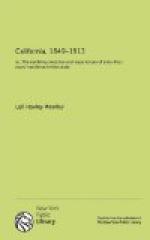On the east side at the southeast corner of Washington, stood the J. B. Haggin home, while on the northeast corner stood that of the Beavers, and at the corner of Jackson, the Tevis.’ In this neighborhood also lived Ina D. Coolbrith, whose home was the center of the literary genius of the State, amongst them being Bret Harte, Joaquin Miller, and Charles Warren Stoddard. Josiah Stanford, a brother of Leland Stanford, lived on the south side of Jackson street, just below the Tevis home.
Here is as good a place as any to give my readers a short account of the Clay Street Hill Underground Cable Railroad, which operated on Clay street from Leavenworth to Kearny streets, a distance of seven blocks, and at an elevation of 307 feet above the starting point. The cable car was the invention of Mr. A. S. Hallidie, who organized the company which built the line. This was the first time that the application of an underground cable was ever used to move street cars, and on August 1, 1873, the first run up the Clay street hill from Kearny to Leavenworth street, was made, and by September 1st the road was in operation. It was a wonderful exhibition, and half the town was there to witness it. Many were in doubt as to the success of the enterprise. The company required the property holders on the hill to subscribe and donate towards the expense, which they did. The writer owning some property there at that time, gave $100.00 to further the enterprise. This was in 1872. An interested Chinese watched the moving cars and remarked: “No pushee, no pullee, go like hellee.”
The California Street Railroad Company used the same device. This line was operated along California street from Kearny to Fillmore and first operated April 9, 1878. It was afterwards extended eastward to Drumm and Market streets and westward to Central Avenue. The Sutter Street R. R. Co. was in operation January 27, 1877, and the Geary street line, February 16, 1880. Cable cars were also operated over Sacramento and Washington streets as well as over Powell at later dates.
[1] A few words might be said concerning the principals of this trouble. King, whose name was James King (before coming to California he had added “of William” so as to distinguish himself from others of that name), came to California November 10th, 1848, engaged in mining and mercantile pursuits and in December 1849 engaged in the banking business in San Francisco. In 1854 he merged with Adams & Co. Shortly afterwards they failed, and he lost everything he possessed. Through the financial backing of his friends, he started the “Daily Evening Bulletin,” October 8th, 1855, a small four-page sheet about 10 x 15 inches in size. He was fearless in his editorials, but always within the bounds of right and justice, and took a strong position against corruption of the city officials and their means of election. His paper grew in circulation and size, and soon outstripped all the other papers combined. November 17th,




